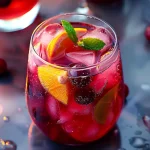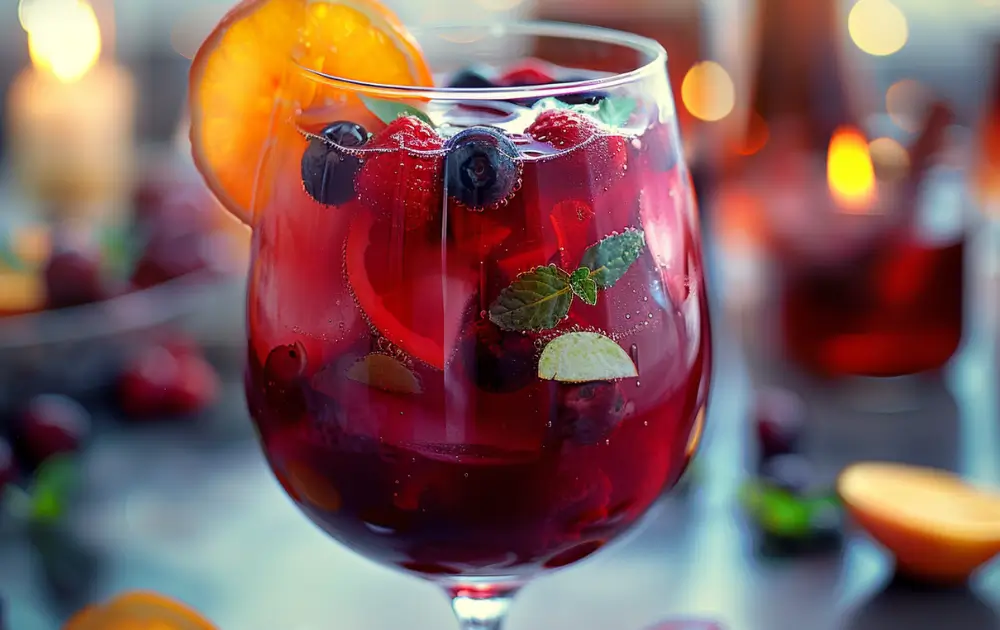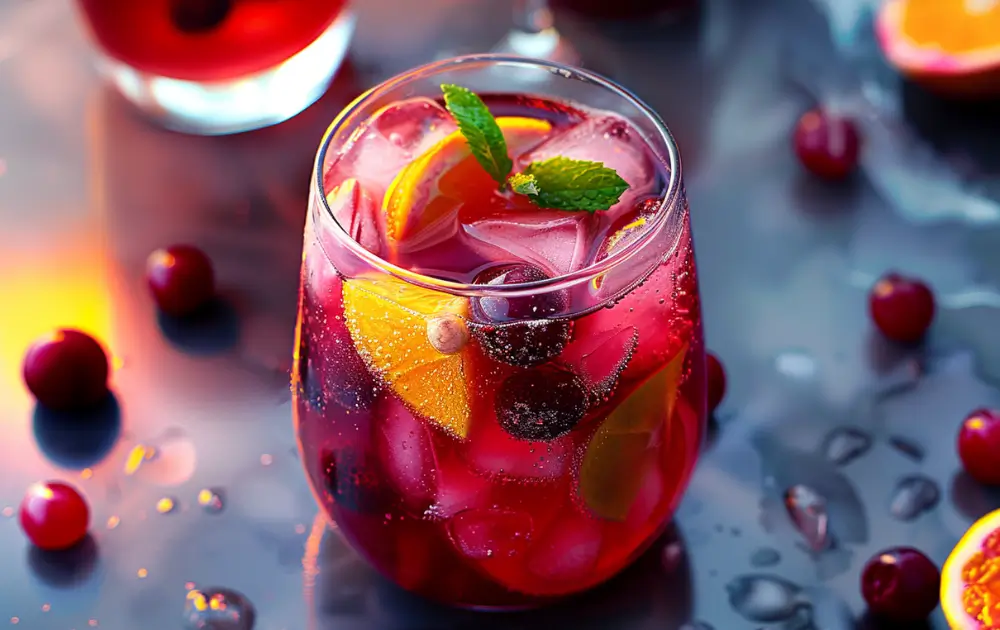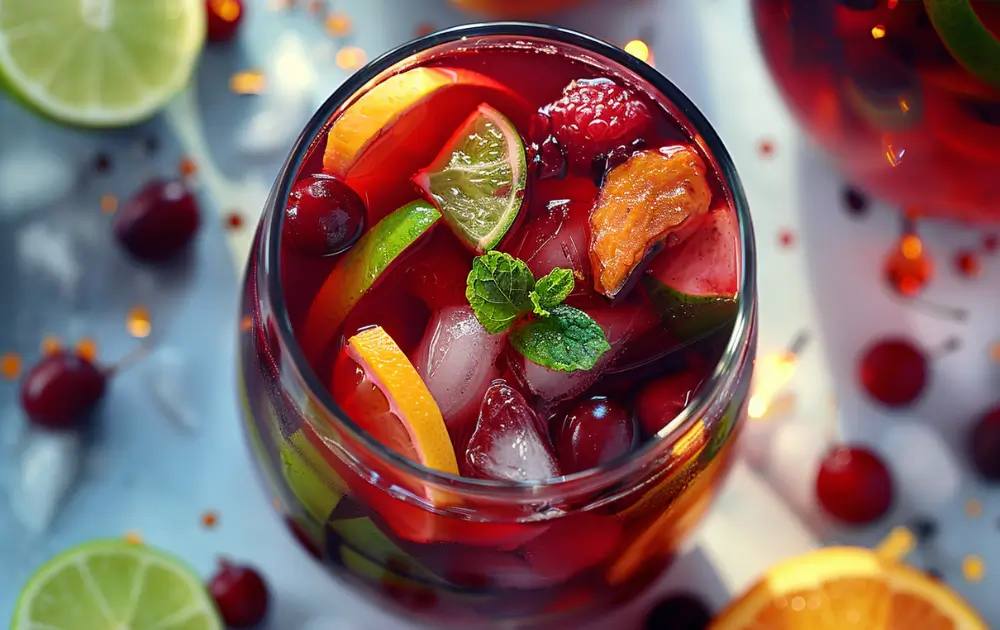Non-Alcoholic Sangria
Non-Alcoholic Sangria offers a refreshing and flavorful alternative to its alcoholic counterpart, making it a perfect drink for all ages and occasions. This delightful beverage combines a variety of fresh fruits with juices and sparkling water to mimic the traditional Spanish sangria, but without the wine. Ideal for family gatherings, picnics, and parties, non-alcoholic sangria allows everyone to enjoy a festive, fruity drink. Its vibrant color and delicious taste make it a popular choice for hosts seeking a sophisticated yet inclusive option.

Non-Alcoholic Sangria
- Total Time: 2 hours 10 minutes
- Yield: 6-8
Description
Non-Alcoholic Sangria is a vibrant and refreshing beverage that captures the essence of traditional sangria without the alcohol, making it suitable for all ages and occasions. This drink combines a variety of fresh fruits with a blend of juices and a touch of sparkle from carbonated water, creating a festive, flavorful, and family-friendly option.
Ingredients
Fresh lemon slices
Fresh lime slices
Fresh orange slices
Cranberries
2 cups cranberry juice
2 cups grape juice
1 cup orange juice
½ cup lemon juice
4 cups San Pellegrino sparkling mineral water OR lemon-lime soda
Instructions
In a large pitcher, add the lemon slices, lime slices, orange slices, and cranberries.
Pour in cranberry juice, grape juice, orange juice, and lemon juice. Stir well.
Refrigerate until ready to use.
Just before serving, add the sparkling mineral water or lemon-lime soda. Mix well.
Notes
- For best results, use freshly squeezed orange and lemon juice.
- The fruit and juice proportions can be varied based on personal taste and seasonal availability.
- Prep Time: 10 minutes
- chill time: 2 hours
- Category: Beverage
- Method: Mixing
- Cuisine: Spanish-inspired
Nutrition
- Calories: 80
- Sugar: 15g
- Sodium: 10mg
- Fat: 0g
- Carbohydrates: 20g
- Fiber: 1g
- Protein: 1g
- Cholesterol: 0mg
Frequently Asked Questions about Non-Alcoholic Sangria
- What fruits work best in NonAlcoholic Sangria? Citrus fruits like oranges and lemons are classic choices, but apples, pears, berries, and tropical fruits like mango and pineapple also add delightful flavors and textures.
- Can NonAlcoholic Sangria be made in advance? Yes, it’s actually recommended to prepare it a few hours ahead or even the night before serving. This allows the flavors of the fruits and juices to meld together, enhancing the overall taste.
- What are the best juices to use in NonAlcoholic Sangria? Grape, cranberry, and pomegranate juices are popular for their rich flavors and deep colors, but apple and orange juices can be used for a lighter, more citrus-forward sangria.
- How can I sweeten NonAlcoholic Sangria without using sugar? Natural sweeteners like honey or agave nectar are great alternatives. You can also rely on naturally sweet juices or ripe fruits to enhance the sweetness.
- What are some creative ways to serve NonAlcoholic Sangria at parties? Serve it in a large, clear punch bowl or dispenser so guests can see the beautiful fruits. Offering a variety of fruit garnishes and a selection of sparkling waters or ginger ales to add right before drinking can also make the serving interactive and fun.
Key Ingredients and Variations
The base of NonAlcoholic Sangria typically includes a mix of fresh fruit slices such as oranges, lemons, limes, apples, and berries. Grape juice or cranberry juice provides the rich, fruity flavor, while sparkling water or ginger ale adds the necessary fizz, giving it that characteristic sangria effervescence. Variations might include the addition of peaches, pineapples, or mangoes for a tropical twist. Some recipes use a combination of fruit juices like apple and orange to enhance the complexity of the flavors.
Preparation Techniques
Preparing NonAlcoholic Sangria is simple and fun. Start by thoroughly washing and slicing the fruits, which can be mixed and matched based on seasonality and personal preference. In a large pitcher, combine the sliced fruits with grape juice or another chosen juice base. For best results, let the mixture chill in the refrigerator for several hours, or overnight, to allow the flavors to meld together. Just before serving, stir in the sparkling water or ginger ale to maintain its bubbly texture.
Serving Suggestions
Non-Alcoholic Sangria is best served chilled. Fill glasses with ice and pour the sangria over the top, making sure each glass gets a good mix of fruit and juice. It can be garnished with a sprig of mint or a cinnamon stick for an extra touch of flavor. This drink is especially popular during the summer months but can be enjoyed year-round at any event. It pairs wonderfully with light appetizers, seafood dishes, and salads, making it a versatile choice that complements a variety of foods.
Cultural Significance and Popularity
Though traditionally associated with alcohol, sangria has evolved to include non-alcoholic versions that maintain the cultural essence of this beloved Spanish beverage. Non-Alcoholic Sangria is particularly popular among health-conscious individuals and those who abstain from alcohol, as it offers a festive, sophisticated option that doesn’t compromise on flavor. Its inclusion in celebrations and family-friendly events underscores its growing popularity as a staple in social gatherings, reflecting a broader trend towards inclusive and diverse beverage options.
Health Benefits of Ingredients
Non-Alcoholic Sangria is not only delicious but also packed with health benefits due to its rich content of fresh fruits. Oranges and lemons provide a healthy dose of vitamin C, which is crucial for immune system support and skin health. Apples and berries contribute dietary fiber, aiding in digestion and promoting a feeling of fullness. The antioxidants found in these fruits can help combat oxidative stress and reduce inflammation in the body. Choosing juices with no added sugars can keep the calorie count lower, making it a healthier choice for those monitoring their sugar intake.
Creative Mixology Tips
To elevate your Non-Alcoholic Sangria, consider experimenting with different combinations of fruits and juices. Adding exotic fruits like dragon fruit or pomegranate seeds can introduce new flavors and vibrant colors. Infusing the sangria with herbs like basil or rosemary can add a refreshing twist and a hint of sophistication. For a winter version, mix in pomegranate juice and cinnamon for a warmer flavor profile. Such creative mixology not only enhances the beverage but also allows you to tailor it to seasonal ingredients and personal tastes.
Event Planning with Non-Alcoholic Sangria
Incorporating Non-Alcoholic Sangria into event planning can greatly enhance any celebration, making it inclusive for guests who prefer or need to avoid alcohol. Offering a beautifully prepared non-alcoholic option at weddings, corporate events, or holiday parties shows consideration for all guests. You can serve it in large, clear dispensers to showcase the colorful fruit pieces, making it as visually appealing as it is tasty. Pairing the sangria with themed decor and serving dishes can also help integrate it seamlessly into the event’s overall aesthetic.
Marketing Non-Alcoholic Beverages
As health trends continue to influence consumer choices, marketing Non-Alcoholic Sangria can attract a wide audience looking for healthier, family-friendly beverage options. Promoting it as a sophisticated, health-conscious choice in restaurants, cafes, and online platforms can appeal to adults and children alike. Highlighting the fresh, natural ingredients and the absence of artificial additives can further appeal to health-focused consumers. Social media campaigns featuring the drink in various settings—such as brunches, baby showers, or summer barbecues—can enhance its appeal and versatility.
Culinary Education and Recipe Development
Non-Alcoholic Sangria presents a valuable learning opportunity in culinary education settings, where students can explore the principles of flavor balancing and recipe development. Teaching how to mix fruits, juices, and carbonation effectively can help aspiring chefs and mixologists understand the dynamics of creating non-alcoholic beverages that are both flavorful and appealing. Developing a signature non-alcoholic sangria recipe can be an excellent project for students, encouraging innovation and creativity while refining their sensory evaluation skills.
Sustainability and Ethical Sourcing
Emphasizing sustainability and ethical sourcing in the preparation of Non-Alcoholic Sangria can enhance both the quality of the drink and its appeal to environmentally conscious consumers. Opting for organic and locally sourced fruits reduces the environmental impact associated with long-distance transportation and supports local economies. Promoting the use of seasonal fruits not only ensures freshness but also aligns with sustainable eating practices by minimizing the carbon footprint. Restaurants and caterers can highlight these aspects in their menus, attracting customers who value ethical consumption choices.
Pairing with Foods
Non-Alcoholic Sangria pairs excellently with a wide range of dishes, making it a versatile choice for dining and entertaining. Its fruity and refreshing nature complements spicy foods, such as tapas or spicy Asian dishes, by providing a sweet counterbalance to the heat. It also goes well with light salads and seafood, enhancing the delicate flavors with its vibrant fruit notes. For dessert pairings, Non-Alcoholic Sangria can accompany rich chocolate cakes or creamy pastries, as the acidity and sweetness cut through the density of the desserts.
Hosting Workshops and Tastings
Organizing workshops and tastings centered around Non-Alcoholic Sangria can be an excellent way for businesses to engage with their community and educate them about non-alcoholic beverage options. These events can demonstrate various preparation techniques, discuss the history and cultural significance of sangria, and explore pairing ideas. Participants can taste different versions of Non-Alcoholic Sangria, which can inspire them to incorporate these beverages into their own events and daily lives, promoting a healthier lifestyle.
Innovative Presentation Techniques
Presentation plays a crucial role in enhancing the appeal of Non-Alcoholic Sangria. Using creative garnishes such as star fruit slices, edible flowers, or bamboo skewers loaded with fruit pieces can turn a simple glass of sangria into an artful display. Serving sangria in unconventional vessels like mason jars, hollowed-out fruits, or elegantly shaped pitchers can add to the aesthetic appeal and make the beverage more memorable. These innovative presentation techniques can be particularly effective in social media marketing, attracting attention and engagement from a wider audience.
Building a Brand Around Health-Conscious Beverages
For businesses looking to specialize in health-conscious beverages, Non-Alcoholic Sangria offers a strong foundation for building a brand identity. By marketing Non-Alcoholic Sangria as a flagship product, businesses can appeal to a broad demographic, including families, health enthusiasts, and those who abstain from alcohol for personal or religious reasons. Developing a range of flavored sangrias or offering customizable options can further enhance the brand, making it synonymous with quality, creativity, and healthfulness. Promoting these values through branding efforts, online content, and community engagement can establish a loyal customer base and differentiate the brand in a competitive market.
Enhancing Community Engagement through Seasonal Events
Engaging with the community through seasonal events that feature Non-Alcoholic Sangria can foster a sense of belonging and celebration among residents. For instance, hosting a spring garden party or a summer beach picnic where Non-Alcoholic Sangria is featured can attract families looking for kid-friendly dining options. Autumn harvest festivals and winter holiday markets are also perfect venues to showcase seasonal variations of the sangria, using ingredients like cranberries and pomegranates. These events not only promote the beverage but also help in building a community-centered brand that values health and inclusivity.
Leveraging Social Media for Promotion
Social media platforms offer a powerful tool for promoting Non-Alcoholic Sangria, especially when targeting health-conscious and younger demographics. Sharing vibrant, high-quality images and videos of the sangria preparation and serving can visually engage potential customers. Hosting live sessions where viewers can learn how to make Non-Alcoholic Sangria at home encourages interaction and can boost followers’ engagement. Additionally, creating shareable content like recipes or fun facts about the benefits of the ingredients can help in spreading the word and attracting a larger audience.
Educational Partnerships with Local Schools
Forming educational partnerships with local schools to teach students about healthy beverage choices can have a lasting impact. Introducing Non-Alcoholic Sangria as part of a nutrition curriculum can help students understand the importance of making healthier drinking choices. Workshops or interactive classes where students can create their own sangria versions with various fruits and juices can make learning fun and practical. These initiatives not only promote healthier lifestyles among young people but also position the brand as a community leader in health education.
Incorporating Eco-friendly Practices
Adopting eco-friendly practices in the sourcing, production, and serving of Non-Alcoholic Sangria can significantly enhance brand reputation. Using biodegradable or reusable serving materials reduces waste and appeals to environmentally conscious consumers. Additionally, highlighting the use of sustainable practices in promotional materials can attract customers who prioritize environmental responsibility. Efforts such as recycling, composting fruit waste, and conserving water in the preparation process can further solidify a commitment to sustainability.
Expanding Menu Options to Include Non-Alcoholic Pairings
Expanding menu options to include food pairings specifically designed for Non-Alcoholic Sangria can enhance the dining experience for customers. Creating a special menu that pairs different flavors of Non-Alcoholic Sangria with complementary appetizers, entrées, or desserts can intrigue customers and encourage them to try new combinations. For example, a citrus-based sangria might pair well with seafood dishes, while a berry-rich sangria could complement a dessert menu featuring chocolate or vanilla flavors. Such curated pairings not only elevate the culinary experience but also showcase the versatility of Non-Alcoholic Sangria in various dining contexts.
Conclusion
Non-Alcoholic Sangria is a versatile and vibrant beverage that offers a refreshing alternative suitable for any occasion. Whether you’re hosting a family-friendly party, looking for a festive addition to a holiday menu, or simply enjoying a quiet evening at home, Non-Alcoholic Sangria brings a burst of flavor and color to the table. Its ability to be customized with a variety of fruits and juices makes it a delightful choice that can be tailored to suit any palate. Embracing Non-Alcoholic Sangria not only caters to all ages and dietary preferences but also adds a touch of elegance and fun to your culinary offerings. With its easy preparation and healthful ingredients, Non-Alcoholic Sangria is sure to be a hit among guests and a staple in your beverage repertoire.




